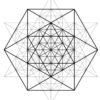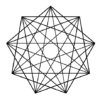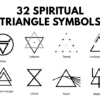
The six-pointed star, or hexagram, is an ancient symbol found across various cultures, religions, and civilizations. It is known as the Star of David in Judaism, the Shatkona in Hinduism, and the Seal of Solomon in Islam. The oldest instance of the star was found in Egypt’s Heliopolis temple, believed to be over 2000 years old. This symbol has graced Indian temples, ancient churches, synagogues, and even 5th-century BC Shinto temples. But what is it about this symbol that makes it so widespread and significant?
In this article, let’s explore in detail the 18 profound meanings associated with the 6-pointed star and various other secret symbolism it carries. So let’s begin.
How to Draw the Six-Pointed Star (Hexagram)
The regular 6-pointed star or hexagram consists of two overlapped equilateral triangles, one facing upward and another facing downward, both having the same center.

To draw the 6-pointed star, you start with a hexagon (6-sided polygon) and connect every second point, starting from the top, to form the first upward-facing triangle. You can then link the remaining points to form the downward-facing triangle to complete the star. This star is also known as the 6/2 star or the Order 2 Six-Pointed star.

Another way is to draw two equilateral triangles, invert one of them, and overlap them in such a way that their centers align with each other (as shown in the image below).
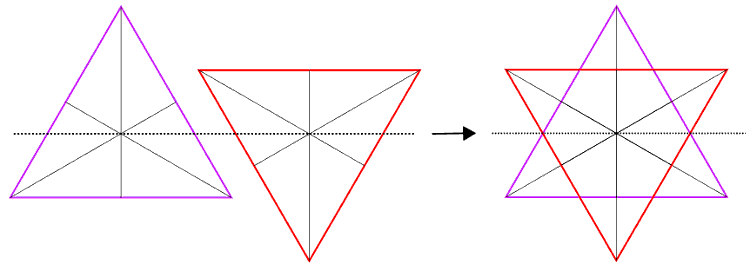
A variation of the Regular Hexagram is the Unicursal Hexagram (as shown in the image below).

What’s unique about the unicursal hexagram is that, unlike the regular hexagram, it can be drawn in a single continuous line without lifting the pen. The following image illustrates the steps involved in drawing the Unicursal hexagram.

Having learned how to draw the hexagram, let’s now explore its various meanings and symbolisms.
18 Meanings Associated with the 6-Pointed Star
1. As Above, So Below

The 6-pointed star represents the concept of As Above, So Below, also known as the Principle of Correspondence.
In the 6-Pointed Star, the triangle facing upward denotes the macrocosm (higher/spiritual realm) and the triangle facing downward represents the microcosm (lower/material world).
The principle of As Above, So Below, suggests that everything in this universe is intricately connected. Every aspect of the macrocosm is present within the microcosm and vice versa. Essentially, the whole is present within its parts, and the parts within the whole.
Thus, in order to understand the universe, all you need to do is understand yourself because the universe (or macrocosm) is within you (microcosm). This could also be interpreted as God, the universe, or source energy being present within every physical form and vice versa.
One practical example of this is that there are over a trillion cells that make up the human body. Every cell (microcosm) contains within it the intelligence that makes up the human body (macrocosm) and the body in turn contains the intelligence of the cells.
Another example is how the human body is perfectly mirrored in natural phenomena, For instance, Phi or the Golden ratio is found in the human body and also in many patterns of nature.
In a way, this concept is very similar to the concept of Yin/Yang which we will look at later in this article. Simply thinking about this concept and everything that it denotes can be a meditative practice in itself.
2. Balance & Harmony

The 6-pointed star symbolizes the harmony and balance between opposing polarities or dimensions of existence.
It underscores the importance of bringing balance and equilibrium in your life, particularly between your higher and lower self, your spiritual and material nature, your conscious and subconscious mind, as well as your thoughts and emotions. Achieving this balance is key to realizing your utmost potential.
3. Duality & Oneness
The six-pointed star represents the concepts of Duality (Dvaita) and Oneness (Advaita).
It suggests that all existence springs from a singular source, but in order to actualize in the physical realm this source must diverge into two counteracting forces. The interaction between these forces is the basis of creation.
The star’s two triangles symbolize these contrasting forces, while the central hexagram, formed by their union, signifies creation. The dot at the center of the hexagram represents the one source from which all things emerge.
4. Creation & Creative Energy
The six-pointed star, as previously discussed, is a potent emblem of creation. The upward-facing triangle in the star symbolizes the spiritual or unmanifested realm, and the downward-facing triangle depicts the material or manifested realm. The harmonious balance between these two aspects forms the crux of all creation.

In Christianity, the star is referred to as the Creator’s Star, symbolizing the seven days of creation. According to the Bible, God created the world in six days and rested on the seventh. The six points of the star represent the six days of creation, while the center point, formed by the intersection of the triangles, signifies the seventh day, or the day of rest (Sabbath).

According to Hinduism, the six-pointed star (known as Shatkona or Six Cornered) signifies the fusion of the Divine masculine & feminine energy. The Divine masculine is embodied by Lord Shiva (upward-facing triangle), and the Divine feminine is represented by Goddess Shakti (downward-facing triangle). This union is seen as the fundamental basis of existence.
In fact, Lord Shiva, is said to have five heads, each symbolizing one of the five elements (Fire, Water, Air, Earth, and Ether). Goddess Parvati, or Shakti, is said to symbolize supreme consciousness. Their offspring, Lord Kartikeya, is said to have six heads – the five elements plus Shakti or pure consciousness. He has the ability to perceive all six directions – East, West, North, South, Above (Heaven), and Below (Earth).
5. Interconnection Between the Spiritual & Material world (Spirit & Matter)
The six-pointed star symbolizes the profound interplay between the spiritual and material realms. The material world becomes alive only when infused with spirit. Hence the union of spirit and matter is the basis of all existence.

The three points of the upward-facing triangle represent the Christian concept of the Trinity: the Father, the Son, and the Holy Ghost. On the other hand, the downward-facing triangle symbolizes the Mind, Body, and Spirit, which are foundational to earthly life.
Father and Mind: The Father in the Christian Trinity can be compared to the Mind. Just as the Father is the source of all creation, the Mind is where all thoughts and ideas originate.
Son and Body: The Son, Jesus Christ, in the Christian faith embodies God’s will in physical form, much like how our Body executes the desires and will of our Mind.
Holy Spirit and Spirit: The Holy Spirit is the force that inspires and motivates, often seen as the presence of God in the world. This is similar to the Spirit within us, which drives us, gives us purpose, and connects us to something greater than our physical existence.
6. Yin and Yang
If you notice closely, you will find that in the Yin-Yang symbol, the Yin contains a portion of Yang and the Yang contains a portion of Yin. This signifies that each opposing polarity intrinsically carries within it an essence of its counterpart. For instance, the masculine contains the feminine and the feminine contains the masculine.

This concept can also be expressed through the six-pointed star. If you draw 3 lines connecting the 3 vertices of the triangle to the midpoints of the opposite side then these three lines will intersect at the center of the triangle.
Furthermore, by connecting the midpoints of all three sides of the triangle (represented by a, b, and c in the image below), we create a smaller triangle that faces in the opposite direction. For instance, if we start with an upward-pointing triangle, the new smaller triangle will point downward, as illustrated in the image below.
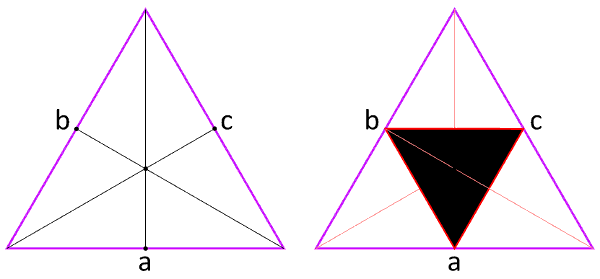
Notice that both triangles (bigger and smaller) have the same center. This proves the concept of the Yin present within the Yang and vice versa.

Now if we join the two main triangles so their centers align (as shown in the image above), a smaller six-pointed star is formed within the larger one, bearing a striking resemblance to the Yin-Yang symbol.
Interestingly, the the 6-pointed star is also present within the Yin Yang symbol as depicted in the image below.

The star is also present within other sacred geometry symbols like the Seed of Life, Flower of Life, and the Metatron’s Cube. We will discuss these later in the article.
7. Infinity & Eternal Life
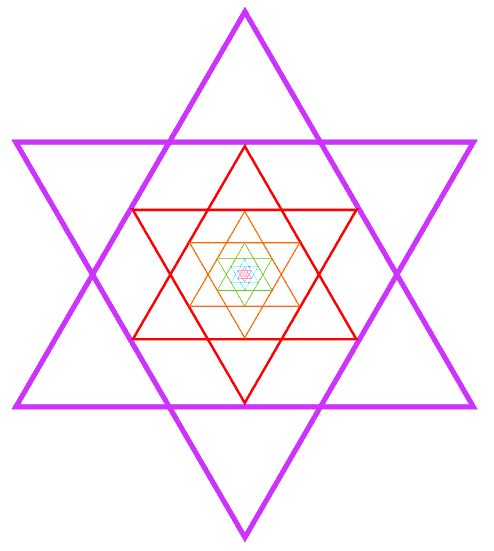
Continuing from the above point, if we keep connecting the midpoints of the sides of the inner triangles, a series of progressively smaller six-pointed stars emerge (as shown in the image above). And this can go on till infinity.
Hence the six-pointed star also represents the concept of infinity and eternal life.
8. Hindu Yantras & Raising Your Consciousness

Yantras are sacred Hindu symbols that are used during prayer and meditation for manifestation and to reach higher states of consciousness. Intriguingly, the six-pointed star frequently figures within many of these Yantras, attesting to the significant value and power that this symbol holds. Some yantras that feature the six-pointed star include:
- Vishnu Yantra: Protects from evil entities and energies.
- Lakshmi Yantra: Helps attract wealth, prosperity, and good fortune.
- Sudarshan Yantra: Brings good luck and removes obstacles from your path.
- Gayatri Yantra: Improves concentration and offers great wisdom.
- Natraja Yantra: Boosts creative energy and offers protection.
9. 3D Merkahab – Light, Body, Spirit

Viewing the six-pointed star in 3D gives rise to the Merkabah, typically depicted as two tetrahedrons rotating in opposite directions.
The term ‘Merkaba’ consists of three separate components: ‘Mer’, signifying light, ‘Ka’, representing spirit, and ‘Ba’, standing for body. When combined, these words convey the harmonious union of spirit and body, enveloped by light.
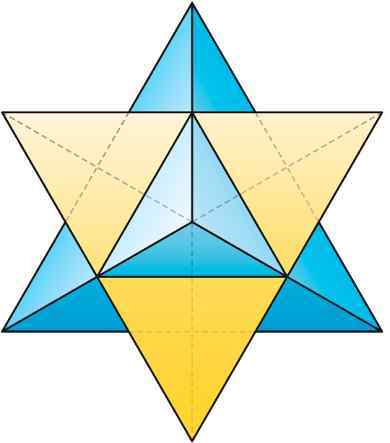
The top tetrahedron, representing spirit or feminine energy, rotates in a counter-clockwise direction, while the lower one, signifying the body or masculine energy, rotates clockwise. Their interaction generates a balanced energy field and light, symbolizing existence.
Meditation on this symbol is believed to elevate the body and soul to higher spiritual planes. Interestingly, in Hebrew, ‘Merkaba’ translates to ‘chariot’.
10. Hexagram Within the Seed of Life, Flower of Life, & Metatron’s Cube
The 6-pointed star is also found within various sacred geometry symbols related to creation like the Seed of Life, Flower of Life, Vesica Piscis, and the Metatron’s Cube.
The hexagram is found 3 times within the Vesica Piscis (as shown in the image below) which is considered the most basic symbol of creation. It also symbolizes the interconnectedness of the spiritual and physical worlds, the birth of the universe, and the concept of duality and oneness.

The hexagram can be found three times within the Seed of Life as shown in the image below. The Seed of Life is believed to contain the very blueprint of the universe.
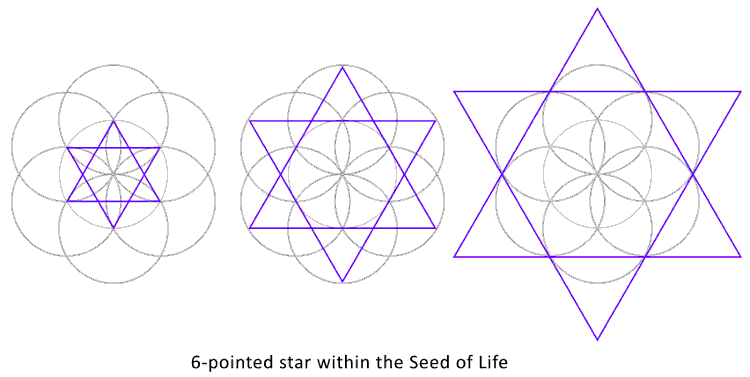
The hexagram can be found three times within the Flower of Life as shown in the image below. The Flower of Life symbolizes creation, interconnectedness of all life, and the foundational patterns of the Universe.

The hexagram can also be found three times within the Metatron’s Cube as shown in the image below. Metatron’s Cube is said to contain the underlying patterns of the universe that shape reality.

In addition, the hexagram can also be found within the Egg of Life, Fruit of Life, Grid of Life, Vector Equilibrium, and several other Sacred Geometry symbols.
11. 4 Elements of Alchemy
The six-pointed star serves as a representation of the five elements – Air, Fire, Water, Earth, and Ether. Among these, Air and Fire are characterized as masculine in nature. Air is symbolized by the upward-pointing triangle, and Fire by an upward-pointing triangle bisected by a horizontal line. Conversely, Earth and Water are feminine in nature and are represented by the downward-pointing triangle and downward-pointing triangle with a horizontal line respectively.
Superimposing these individual symbols results in the two six-pointed stars also known as the Double Hexgram as depicted in the image below. The star’s central core signifies ether, Akasha, or spirit energy.

Thus, the six-pointed star embodies the balance and interconnectedness of the five elements.
12. Relation to Secret Code 369 & Higher Consciousness
It’s interesting to note that the 6-pointed star is related to the secret code 369 which is associated with creation, manifestation, unity, higher consciousness, and source energy.

In 369, the number 3 is represented by a single triangle as it has 3 vertices. This triangle represents becoming conscious of the Body, Mind, and Soul as the first step toward reaching a higher state of consciousness.
Number 6 is represented by the 6-pointed star that contains 2 triangles and 6 vertices. This star represents bringing into balance the two opposing elements of spirituality and materialism. This balance is the crux of transformation.
Finally, the number 9 is represented by the 9/3 9-Pointed Star that is made of 3 interlocking triangles and contains a total of 9 vertices/corners. This star represents the state of completion or reaching a higher state of consciousness where you merge with the source itself.
13. Hexagram and Heart Chakra – Self Awareness, Self Love, & Positive Relationships

Chakras are energy centers within the body. There are 7 chakras in total and each chakra is represented by a unique symbol.
The Anahata or Heart Chakra is depicted as a six-pointed star encircled by 12 lotus petals. This star symbolizes the union of Lord Shiva (Divine Masculine) and Goddess Shakti (Divine Feminine). When these two energies are harmonized, the heart chakra becomes open and activated.
When your heart chakra is open, you gain heightened self-awareness, improved control over your thoughts and emotions, and an increase in self-love. Furthermore, you’re able to cultivate meaningful relationships that add value to your life. The openness of this chakra also invites elements into your life that foster personal growth and aid you in reaching your utmost potential.
14. Meditation & Moksha
In Hinduism and Buddhism, the hexagram symbolizes the highest state of meditation and the connection between man and the divine which results in moksha.
Moksha signifies a state of liberation from thoughts and ego, which results in unity with the absolute divine. It also represents freedom from the cycle of rebirth, which could metaphorically suggest the ceasing of the ego’s tendency to take on new forms to perpetuate its existence.
15. 7 Days of the Week

Much like the 7-pointed star, the 6-pointed star also represents the 7 days of the week and the 7 original astrological planets.
Each vertex of the star represents a day of the week, while the central core represents Sunday, or the Sabbath. This day, set aside for relaxation and spiritual contemplation, is designed to energize you for the creative and productive weekdays ahead.
The sabbat (represented by the Sun) brings balance and perspective to the other six weekdays in the same way as the Sun gives energy, vitality, and direction to the other planets.
16. Seven Alchemical Planets and Metals

The 6-pointed star also signifies the seven alchemical metals: Gold, Silver, Iron, Mercury, Copper, Tin, and Lead. It is to be noted that these 7 metals are related to the 7 planets we discussed above. Gold is associated with the Sun, Silver with Moon, Tin with Mars, Lead with Saturn, Iron with Jupiter, and Copper with Venus.
The central core of the star represents Gold, while the other six vertices correspond to the remaining six metals. This star symbolizes the interconnectedness of these metals and the alchemical belief that even base metals like Lead can be transmuted into Gold, a highly desired metal. Gold also represents life and light as it is related to the Sun.
This serves as a metaphor for identifying and transforming less desirable elements within yourself that don’t serve your goals and transforming/purifying them into something more valuable and desirable.
17. Protection & Good Energy
The 6-pointed star has also been used as a powerful symbol of protection in various cultures and traditions. For instance in medieval Jewish culture, the star was used as a protective amulet against evil spirits and negative energies. It’s believed that King David used this symbol on his shield for protection and triumph in battle, earning the star its Hebrew name, the ‘Shield of David’ or ‘Magen David’.
Similarly, in Islamic folklore the star is known as the Seal of Solomon, and is believed to have supernatural properties. The most famous legend is that King Solomon used this seal to control and command djinn (or genies), spirits, and demons, and to speak with animals. In addition to commanding spirits, Solomon was also said to be able to use the seal to cast spells and perform miracles.
18. Unicursal Hexagram – Unity, Balance, & the Cyclic Nature of Life

As discussed earlier, a variation of the regular hexagram is the Unicursal hexagram. What’s unique about this type of hexagram is that unlike the regular hexagram (which consists of two overlaid triangles), it can be drawn in one continuous line without lifting the pen. Because of this, the unicursal hexagram symbolizes unity, balance, protection, infinity, and the cyclic nature of life. It also represents the power of the 7 original celestial bodies – Sun, Moon, Mercury, Mars, Jupiter, Venus, and Saturn.
Since ancient times, this symbol has been used in alchemy and ritual magic as a symbol of protection, and balance and to invoke the power of the planets and elements. It has also been used as a tool for meditation to reach higher states of consciousness.
Conclusion
The six-pointed star is a potent emblem representing creation, creative energy, eternal life, balance, harmony, protection, eternal life, and the attainment of higher spiritual goals. It’s unsurprising that this star has been adopted by diverse cultures and religions to convey such profound concepts.
Although, it needs to be said that the star stands independent of its users and can be employed as a symbol by anyone, regardless of religious or cultural affiliations. You don’t need to subscribe to any particular tradition or religion to incorporate this powerful star into your life. So if you resonate with this star, by all means, go ahead and start using it in your life and reaping all the benefits it has to offer.


